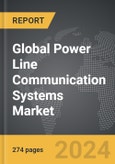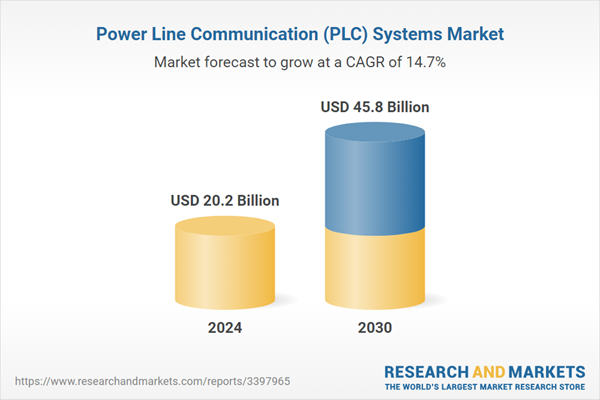The global market for Power Line Communication (PLC) Systems was valued at US$20.2 Billion in 2024 and is projected to reach US$45.8 Billion by 2030, growing at a CAGR of 14.7% from 2024 to 2030. This comprehensive report provides an in-depth analysis of market trends, drivers, and forecasts, helping you make informed business decisions. The report includes the most recent global tariff developments and how they impact the Power Line Communication (PLC) Systems market.
PLC systems are employed in several key sectors including smart grids, where they enhance energy management and efficiency by integrating communication capabilities directly into electrical distribution systems. Within automotive systems, PLC facilitates internal data transmission for monitoring and entertainment purposes, and in utilities, it supports sophisticated control mechanisms that improve operational efficiency and resource management. The technology’s adaptability is showcased in its application across varied environments, offering solutions that include real-time health monitoring and disease management in healthcare, and enhanced operational controls in industrial settings. The ability to use PLC for smart grid management exemplifies its potential, allowing for effective load balancing and real-time operational adjustments which are critical in maintaining grid stability and efficiency.
The expansion and sophistication of PLC technology are driven by several growth factors. Advancements in modulation techniques and increased bandwidth capabilities enhance the system's data transmission efficiency, making it suitable for high-speed communications required in modern applications. Integration with renewable energy systems and the growing need for grid modernization further propel the adoption of PLC, as these systems require robust, real-time monitoring and control mechanisms that PLC can provide. Additionally, governmental regulations and incentives supporting smart grid and renewable technologies encourage the adoption of PLC systems. Standardization efforts improve device interoperability, facilitating broader use across different technologies and platforms. Consumer awareness and demand for smart home technologies also boost PLC's adoption, as more users recognize the benefits of integrated home systems. In industrial sectors, the push towards automation and the integration of IoT devices underscore the need for reliable communication systems like PLC, which can efficiently link various sensors and controllers within extensive facilities. Lastly, the inherent cost-effectiveness of utilizing existing electrical infrastructures, along with enhancements in security features, makes PLC an increasingly attractive option for a wide range of applications, further underlining its pivotal role in the evolution of communication and energy management systems.
Segments: Type (Broadband PLC, Narrowband PLC); Application (Commercial, Residential, Automotive, Oil & Gas, Telecommunication, Power Distribution, Other Applications).
Geographic Regions/Countries: World; United States; Canada; Japan; China; Europe (France; Germany; Italy; United Kingdom; and Rest of Europe); Asia-Pacific; Rest of World.
The analysts continuously track trade developments worldwide, drawing insights from leading global economists and over 200 industry and policy institutions, including think tanks, trade organizations, and national economic advisory bodies. This intelligence is integrated into forecasting models to provide timely, data-driven analysis of emerging risks and opportunities.
Global Power Line Communication (PLC) Systems Market - Key Trends and Drivers Summarized
Power Line Communication (PLC) systems, also known as Power Line Telecommunications, utilize existing electrical wiring to transmit data, voice, and video communications, offering a versatile and cost-effective solution particularly useful in the Internet-of-Things (IoT) and smart grid applications. This technology enables both power and data transmission over the same electrical lines through various modulation techniques, eliminating the need for additional cabling. PLC is crucial in applications ranging from in-house networking and broadband internet access in remote areas to smart home systems and utility functions like automatic meter reading. Such applications leverage the existing electrical infrastructure, reducing the need for extensive new network setups and thereby facilitating broader adoption, especially in under-served or difficult-to-reach areas.PLC systems are employed in several key sectors including smart grids, where they enhance energy management and efficiency by integrating communication capabilities directly into electrical distribution systems. Within automotive systems, PLC facilitates internal data transmission for monitoring and entertainment purposes, and in utilities, it supports sophisticated control mechanisms that improve operational efficiency and resource management. The technology’s adaptability is showcased in its application across varied environments, offering solutions that include real-time health monitoring and disease management in healthcare, and enhanced operational controls in industrial settings. The ability to use PLC for smart grid management exemplifies its potential, allowing for effective load balancing and real-time operational adjustments which are critical in maintaining grid stability and efficiency.
The expansion and sophistication of PLC technology are driven by several growth factors. Advancements in modulation techniques and increased bandwidth capabilities enhance the system's data transmission efficiency, making it suitable for high-speed communications required in modern applications. Integration with renewable energy systems and the growing need for grid modernization further propel the adoption of PLC, as these systems require robust, real-time monitoring and control mechanisms that PLC can provide. Additionally, governmental regulations and incentives supporting smart grid and renewable technologies encourage the adoption of PLC systems. Standardization efforts improve device interoperability, facilitating broader use across different technologies and platforms. Consumer awareness and demand for smart home technologies also boost PLC's adoption, as more users recognize the benefits of integrated home systems. In industrial sectors, the push towards automation and the integration of IoT devices underscore the need for reliable communication systems like PLC, which can efficiently link various sensors and controllers within extensive facilities. Lastly, the inherent cost-effectiveness of utilizing existing electrical infrastructures, along with enhancements in security features, makes PLC an increasingly attractive option for a wide range of applications, further underlining its pivotal role in the evolution of communication and energy management systems.
Report Scope
The report analyzes the Power Line Communication (PLC) Systems market, presented in terms of units. The analysis covers the key segments and geographic regions outlined below.Segments: Type (Broadband PLC, Narrowband PLC); Application (Commercial, Residential, Automotive, Oil & Gas, Telecommunication, Power Distribution, Other Applications).
Geographic Regions/Countries: World; United States; Canada; Japan; China; Europe (France; Germany; Italy; United Kingdom; and Rest of Europe); Asia-Pacific; Rest of World.
Key Insights:
- Market Growth: Understand the significant growth trajectory of the Broadband PLC segment, which is expected to reach US$23.0 Billion by 2030 with a CAGR of a 13.3%. The Narrowband PLC segment is also set to grow at 16.1% CAGR over the analysis period.
- Regional Analysis: Gain insights into the U.S. market, valued at $5.6 Billion in 2024, and China, forecasted to grow at an impressive 13.9% CAGR to reach $7.0 Billion by 2030. Discover growth trends in other key regions, including Japan, Canada, Germany, and the Asia-Pacific.
Why You Should Buy This Report:
- Detailed Market Analysis: Access a thorough analysis of the Global Power Line Communication (PLC) Systems Market, covering all major geographic regions and market segments.
- Competitive Insights: Get an overview of the competitive landscape, including the market presence of major players across different geographies.
- Future Trends and Drivers: Understand the key trends and drivers shaping the future of the Global Power Line Communication (PLC) Systems Market.
- Actionable Insights: Benefit from actionable insights that can help you identify new revenue opportunities and make strategic business decisions.
Key Questions Answered:
- How is the Global Power Line Communication (PLC) Systems Market expected to evolve by 2030?
- What are the main drivers and restraints affecting the market?
- Which market segments will grow the most over the forecast period?
- How will market shares for different regions and segments change by 2030?
- Who are the leading players in the market, and what are their prospects?
Report Features:
- Comprehensive Market Data: Independent analysis of annual sales and market forecasts in US$ Million from 2024 to 2030.
- In-Depth Regional Analysis: Detailed insights into key markets, including the U.S., China, Japan, Canada, Europe, Asia-Pacific, Latin America, Middle East, and Africa.
- Company Profiles: Coverage of players such as ABB Ltd., Aclara Technologies LLC, Amperion, Inc., Atmel Corp., Billion Electric Co. Ltd. and more.
- Complimentary Updates: Receive free report updates for one year to keep you informed of the latest market developments.
Some of the 44 companies featured in this Power Line Communication (PLC) Systems market report include:
- ABB Ltd.
- Aclara Technologies LLC
- Amperion, Inc.
- Atmel Corp.
- Billion Electric Co. Ltd.
- Cypress Semiconductor Corp.
- D-link System, Inc.
- Eaton Corp.
- Echelon Corp.
- Elster Group SE
- GE Grid Solutions
- Landis+Gyr AG
- Marvell Technology Group Ltd.
- Maxim Integrated Products, Inc.
- Microchip Technology, Inc.
- NXP Semiconductor NV
- Power Plus Communications AG
- Qualcomm Atheros, Inc.
- Renesas Electronics Corporation
- Semitech Semiconductor Pte Ltd.
- Siemens AG
- ST&T Electric Corporation
- STMicroelectronics N.V
- Texas Instruments Inc.
- TP-LINK Technologies Co., Ltd.
Tariff Impact Analysis: Key Insights for 2025
Global tariff negotiations across 180+ countries are reshaping supply chains, costs, and competitiveness. This report reflects the latest developments as of April 2025 and incorporates forward-looking insights into the market outlook.The analysts continuously track trade developments worldwide, drawing insights from leading global economists and over 200 industry and policy institutions, including think tanks, trade organizations, and national economic advisory bodies. This intelligence is integrated into forecasting models to provide timely, data-driven analysis of emerging risks and opportunities.
What’s Included in This Edition:
- Tariff-adjusted market forecasts by region and segment
- Analysis of cost and supply chain implications by sourcing and trade exposure
- Strategic insights into geographic shifts
Buyers receive a free July 2025 update with:
- Finalized tariff impacts and new trade agreement effects
- Updated projections reflecting global sourcing and cost shifts
- Expanded country-specific coverage across the industry
Table of Contents
I. METHODOLOGYII. EXECUTIVE SUMMARY2. FOCUS ON SELECT PLAYERSIII. MARKET ANALYSISIV. COMPETITION
1. MARKET OVERVIEW
3. MARKET TRENDS & DRIVERS
4. GLOBAL MARKET PERSPECTIVE
UNITED STATES
CANADA
JAPAN
CHINA
EUROPE
FRANCE
GERMANY
ITALY
UNITED KINGDOM
REST OF EUROPE
ASIA-PACIFIC
REST OF WORLD
Companies Mentioned (Partial List)
A selection of companies mentioned in this report includes, but is not limited to:
- ABB Ltd.
- Aclara Technologies LLC
- Amperion, Inc.
- Atmel Corp.
- Billion Electric Co. Ltd.
- Cypress Semiconductor Corp.
- D-link System, Inc.
- Eaton Corp.
- Echelon Corp.
- Elster Group SE
- GE Grid Solutions
- Landis+Gyr AG
- Marvell Technology Group Ltd.
- Maxim Integrated Products, Inc.
- Microchip Technology, Inc.
- NXP Semiconductor NV
- Power Plus Communications AG
- Qualcomm Atheros, Inc.
- Renesas Electronics Corporation
- Semitech Semiconductor Pte Ltd.
- Siemens AG
- ST&T Electric Corporation
- STMicroelectronics N.V
- Texas Instruments Inc.
- TP-LINK Technologies Co., Ltd.
Table Information
| Report Attribute | Details |
|---|---|
| No. of Pages | 274 |
| Published | April 2025 |
| Forecast Period | 2024 - 2030 |
| Estimated Market Value ( USD | $ 20.2 Billion |
| Forecasted Market Value ( USD | $ 45.8 Billion |
| Compound Annual Growth Rate | 14.7% |
| Regions Covered | Global |









